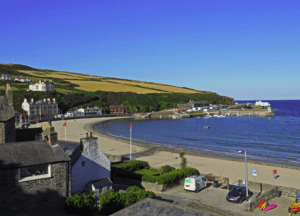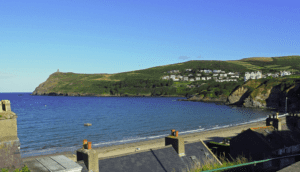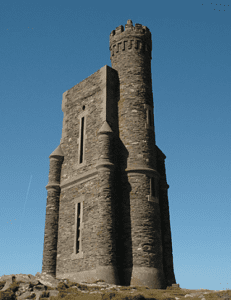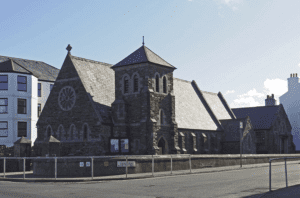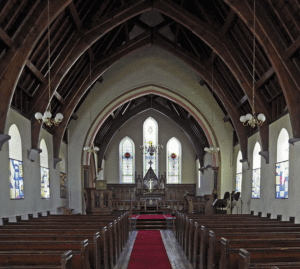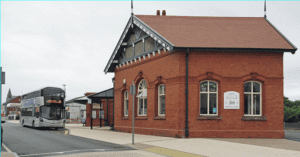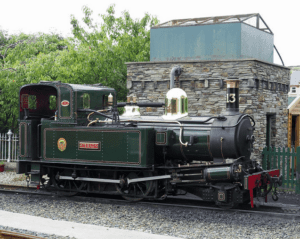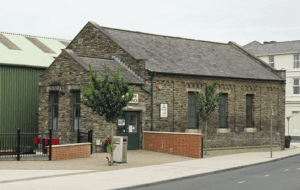At the southern end of the island, Port Erin is a small settlement around a beautiful enclosed sandy beach. It is protected by Bradda Head to the north and the Mull Peninsula to the south. On a clear day there are views across to the Mountains of Mourne, nearly 30 miles to the west.
Before the arrival of railway in 1874, Port Erin was a small settlement with a few houses along Shore Road, and scattered dwellings on Bradda Head. The population earned their living from fishing, subsistence farming and mining. The shallow bay provided easy landing for the fishing boats.
A vein of copper ran through the Bradda headland and was mined in the C18th and C19th. The remains of the engine house, adit and entrance shaft of the South Bradda Mine are still visible on the shore below Milner’s Tower.
Construction of a breakwater began in the 1863 as it was hoped this would mark the start of a new ferry service between Port Erin and Holyhead, and provided the incentive for the Isle of Man railway Company to extend their line from Castletown to Port Erin. Unfortunately this was destroyed during a severe storm a few years later and was never rebuilt. The remains of the breakwater can be seen at low tide and are marked by a buoy. The ferry service never materialised, although the railway did arrive in 1874.
This brought Victorian holiday makers to Port Erin and it was the choice for the more well to do visitors. Splendid Victorian hotels appeared along the Promenade above the beach. Smaller guest houses soon appeared as well as a shopping area. An open air swimming pool was constructed at the base of the cliffs and was unusual at the time as it allowed mixed bathing. It closed in 1981 and is now looking very dilapidated.
William Milner, a wealthy Birkenhead safe maker spent part of the year in Port Erin and retired there. He set up a number of charities to help local residents, particularly poverty stricken fishermen. He was responsible for building the first hotel, Falcon’s Nest, St Catherine’s Church, a terrace of cottages along the sea shore and his own private residence “the Rest”. The tower on top of Bradda Head was erected by public subscription in his memory. It is said to resemble the key to one of his safes.
Tourist numbers dropped during both World Wars and, during the Second World War, many of the hotels were used to house women and children of ‘enemy aliens.’ Tourism revived after the war but declined again in the 1960s and 70s with the arrival of affordable foreign holidays Many of the hotels were closed, turned into flats or pulled down. Fishing and mining is long gone and now it is now primarily a dormitory settlement for Douglas.
Port Erin remains a thriving centre with a good shopping centre and a large branch of Shoprite, the very good Manx supermarket. There is also a very good “fish and chip shop. “:https://www.silvertraveladvisor.com/review/restaurant/193756-review-port-erin-chippie In the summer the holiday spirit revives. The large expanse of sand with its two swimming rafts and beach ball net is as popular as ever. Milner’s Tower stands proud on Bradda Head and is a short walk along the beach and up through Bradda Glen. Climb the 40 steps for views of the surrounding countryside.
St Catherine’s Well is the site of a natural spring which flows under the roadway onto the beach. The early Irish missionaries built a small chapel (keeill) near it and the well became known for its healing properties. The Keeill has long disappeared under the waves, but when William Milner died in 1874, he left a plot of land near the well along with £1000 to build a new church in memory of his wife Jane. It saved parishioners the walk to Kirk Christ, the parish church between Port Erin and Port St Mary. The church was to be dedicated to St Catherine. This is open and is a simple C19th building.
Next to it is the “Erin Arts Centre”:https://www.erinartscentre.com/home.html Erin Arts Centre which hosts a series of musical events throughout the year as well as films and dramatic productions
To the south, the Mull Peninsula protects the small harbour with its Art Deco RNLI station, dating from 1924 and one of five on the island. The coastguard and Harbour Master are based in small buildings by it. Close by was the University of Liverpool Marine Biology Research Station which closed in 2006. Beyond, the Raad Ny Foillan, the Coastal Footpath, is a dramatic walk along the cliffs to “The Sound.”:http://wasleys.org.uk/eleanor/man/south/sound/index.html .
Port Erin in the terminus of the “Isle of Man Steam Railway”:http://wasleys.org.uk/eleanor/man/transport/steamrailway/index.html which runs during the summer months. The splendid 1904 red Ruabon brick station building is in the centre of the town and with the bus terminus outside, is now the transport hub for people arriving by public transport. With its attention to detail, it has been described as the “most beautiful building in the town”.
The platform is shorter than in its Victorian heyday and the sidings are now the bus depot for Bus Vannin. The engine shed and water tower still survive. The excellent small “museum”:http://wasleys.org.uk/eleanor/man/transport/museum/index.html is in the former goods shed.
It is an excellent choice for a holiday base.
There are more pictures “here.”:http://wasleys.org.uk/eleanor/man/south/porterin/index.html
